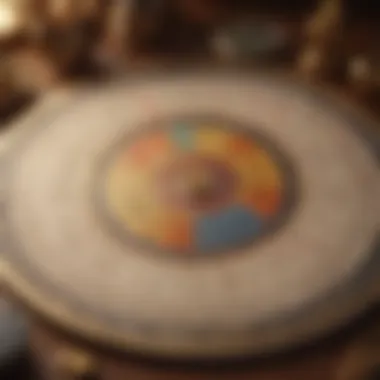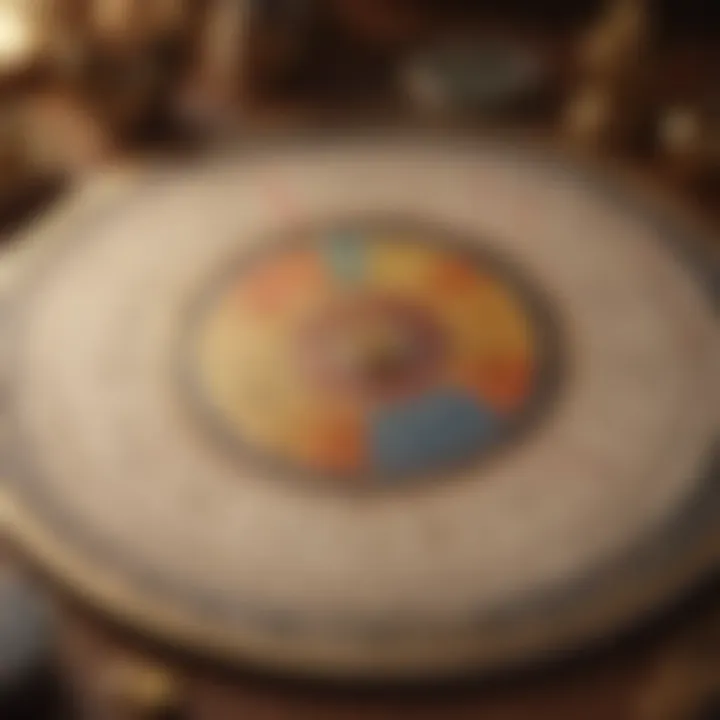Understanding Birth Charts in Astrology: A Deep Dive


Intro
Astrology has long captivated the human mind, offering insights into the intricate tapestry of life. The birth chart, often referred to as the natal chart, serves as a blueprint revealing the cosmic influences at play during one’s birth. Understanding this chart is key for those seeking personal insight and spiritual growth. This section lays the foundation for a comprehensive exploration of birth charts, delving into zodiac signs, astrological insights, and horoscope predictions.
Understanding the Zodiac
Overview of Zodiac Signs
The zodiac consists of twelve distinct signs, each representing unique personality traits and ways of interacting with the world. From Aries to Pisces, each sign covers specific dates, aligning with certain celestial bodies’ positions at one’s time of birth.
Sign Traits and Characteristics
Each sign holds its own set of characteristics. For instance, Taurus tends to embody steadiness and practicality, while Gemini is often seen as adaptable and curious. Here is a brief overview of select zodiac signs:
- Aries: Bold, competitive, and impulsive.
- Cancer: Nurturing, intuitive, and sensitive.
- Libra: Diplomatic, charming, and sociable.
- Capricorn: Disciplined, responsible, and ambitious.
Elemental Qualities
The zodiac signs are also categorized into four elemental groups—Fire, Earth, Air, and Water. Each element further defines how the signs express their traits.
- Fire: Enthusiastic, leaders, spontaneous.
- Earth: Grounded, reliable, practical.
- Air: Intellectual, communicative, adaptable.
- Water: Emotional, intuitive, caring.
Astrological Insights
Current Astrological Trends
Astrology is dynamic; current trends impact individual lives based on the positioning of planets. Awareness of these trends can provide valuable context to personal experiences. Noticing how these influences align with everyday challenges and opportunities can deepen understanding.
Influence of Celestial Events
Solar and lunar eclipses, retrogrades, and transits of significant planets can affect personal energies. Being mindful of these events allows individuals to navigate challenges more efficiently. For example, Mercury retrograde might be a period of miscommunications, hence people might take extra caution with plans during such times.
How to Interpret Your Birth Chart
Interpreting a birth chart involves examining its various components, including houses, aspects, and planetary alignments. Understanding the relationship between these elements fosters greater awareness of oneself and influences key life events.
“A strong birth chart provides clarity on personal strengths and areas for growth.”
Horoscope and Predictions
Monthly or Weekly Forecasts
Horoscopes offer timely guidance based on current astrological positions. These short assessments provide snapshots to help navigate daily life.
Personalized Horoscope Reading
A personalized horoscope reading allows for a much deeper insight. It considers one's unique birth chart and the collective influence of the cosmos, tailoring predictions to the individual.
Compatibility Readings based on Zodiac Signs
Compatibility readings assess how different signs interact. Understanding these dynamics can assist in personal relationships, whether romantic or platonic. By recognizing affinities and oppositions, one can foster healthier connections.
What is a Birth Chart
A birth chart, also known as a natal chart, serves as a foundational element in astrology. It is a unique map of the positions of celestial bodies at the exact moment of an individual's birth. Understanding this chart can provide significant insights into a person’s character, tendencies, and potential life path. The purpose of examining birth charts lies not only in predicting future events but in facilitating deeper self-awareness and personal growth. This article explores the essential aspects and components of a birth chart and its role in astrology.
Definition and Purpose
A birth chart is generated using key details, including the date, time, and place of birth. It visualizes the placement of the Sun, Moon, and planets within the twelve zodiac signs and astrological houses. Each of these elements reveals specific insights about an individual.
The primary purpose of a birth chart is to act as a tool for self-discovery. It offers a detailed perspective on one’s inherent traits, motivations, and challenges. For many, this chart can serve as a guide in understanding their emotional and psychological landscape. By recognizing patterns and tendencies outlined in the chart, individuals can make informed decisions in various aspects of life.
Historical Background
The concept of birth charts has origins stretching back thousands of years. Astrology as a practice began in ancient civilizations like Babylon, where people observed celestial movements and their possible impacts on human affairs. As civilizations advanced, so did the methods of charting celestial bodies.
In ancient Greece, astrological practices were further developed, becoming more systematic. Figures like Ptolemy contributed to the understanding of planetary influences based on mathematical calculations. Over time, the use of birth charts became widespread, with scholars and astrologers refining the methods.
The notion that celestial bodies can influence events on Earth is a foundational aspect of many astrological belief systems. Today, birth charts are used not only for individual insights but also in broader astrological interpretations. However, while the roots of birth charts lie in ancient tradition, their relevance continues to resonate in modern contexts.
Components of a Birth Chart
The study of a birth chart entails a scientific yet artful understanding of cosmic influences on human lives. Components of a birth chart are not just informative; they are crucial for interpreting one's unique astrological signature. Each component—the zodiac signs, planets, houses, and aspects—works in harmony, providing a multifaceted view of an individual's traits and tendencies. Recognizing the individual elements enhances one's grasp of how to apply this knowledge for personal insight and growth.


The Twelve Zodiac Signs
The foundation of astrology lies within the twelve zodiac signs. Each sign represents distinct characteristics, and their influence pervades the entire birth chart. The twelve signs are Aries, Taurus, Gemini, Cancer, Leo, Virgo, Libra, Scorpio, Sagittarius, Capricorn, Aquarius, and Pisces.
Each zodiac sign operates within a specific elemental and modality framework. The elements—fire, earth, air, and water—illustrate fundamental qualities, while modalities—cardinal, fixed, and mutable—highlight how these energies express themselves.
For example, Aries embodies the spirit of initiation and action, while Libra centers around balance and relationships. Understanding these traits allows a nuanced interpretation of how one's sun sign, moon sign, and other placements interact across the chart.
Planets and Their Influences
As the planets move through the zodiac, they impart different energies that influence personality traits and behavior. In astrology, the emphasis is not solely placed on the sun but also includes the moon and other celestial bodies.
The function of each planet is symbolic, with each representing distinct facets of human experience. For instance, Mercury governs communication, Venus dictates love and beauty, and Mars represents energy and aggression.
Key planets and associations:
- Sun: Self-expression, ego
- Moon: Emotions, subconscious
- Mercury: Communication, thought
- Venus: Affection, harmony
- Mars: Action, willpower
- Jupiter: Growth, expansion
- Saturn: Responsibility, discipline
- Uranus: Innovation, change
- Neptune: Intuition, dreams
- Pluto: Transformation, power
Understanding the role of planets in a birth chart equips enthusiasts to decipher complex behaviors and motivations.
Houses in Astrology
Astrological houses, of which there are twelve, represent different life areas and experiences. Each house also connects to specific signs and planets, creating layers of meaning within the chart.
For example, the first house is often linked to identity and self-image, while the fourth house relates to home and family. This structure helps categorize life experiences, allowing individuals to discover personal and practical insights.
House associations:
- First House: Self, appearance
- Second House: Values, finances
- Third House: Communication, learning
- Fourth House: Home, family
- Fifth House: Creativity, pleasure
- Sixth House: Health, work
- Seventh House: Partnerships, marriage
- Eighth House: Transformation, shared resources
- Ninth House: Philosophy, travel
- Tenth House: Career, status
- Eleventh House: Friendships, community
- Twelfth House: Spirituality, subconscious
Aspects and Relationships
Aspects define the relationships between planets based on their angles to one another. These angles reveal how planetary energies blend or clash within the individual. Various aspects—conjunction, sextile, square, trine, and opposition—elucidate how planets interact in a birth chart.
Understanding aspects adds depth to the analysis. For example, a square causes friction, leading to conflict or challenges, while a trine fosters harmony and ease. This information can be instrumental for astrologers to comprehend the complexities present in the personality, enabling a holistic approach to self-discovery.
In summary, the components of a birth chart—zodiac signs, planets, houses, and aspects—are interlinked. Together, they create a comprehensive and insightful portrayal of an individual's astrological blueprint.
Calculating a Birth Chart
Calculating a birth chart is a fundamental aspect of astrology that serves as the foundation for understanding celestial influences on individuals. This process involves multiple components that help to pinpoint the precise positions of planets, signs, and houses at the time of a person's birth. Grasping the importance of this calculation is essential for anyone looking to gain insights into their personality and life path. The calculation process not only reveals astrological significance but also emphasizes how various cosmic elements interact to shape an individual’s experiences and tendencies.
Required Information
To calculate an accurate birth chart, certain essential details are necessary. Each piece of information helps to tailor the chart specifically to the individual’s circumstances. The following list outlines the key details required:
- Date of Birth: The precise date provides clarity on the celestial positions of planets at the moment of birth.
- Time of Birth: Accurate timing is crucial as it influences the positioning of the Ascendant and houses in the chart.
- Place of Birth: Geographic location affects the chart's layout, as celestial positions may vary based on where one is born.
Gathering this information ensures that the birth chart reflects the cosmic influences at the time of birth in a way that is meaningful for interpretation.
Tools for Calculation
Several tools assist in the calculation of birth charts, ranging from manual computations to sophisticated software solutions. Each of these methods offers different levels of detail and complexity:
- Astrology Software: Tools like Astrolog, AstroSeek, and TimePassages offer automated calculations with extensive features for detailed chart analysis.
- Online Calculators: Websites such as astro.com allow users to input their birth details and receive a generated birth chart along with interpretations.
- Books and Reference Guides: Traditional methods involve consulting astrological texts to manually calculate the positions and chart layouts.
Using these tools not only streamlines the process but also provides users with varied interpretations of their birth charts, leading to deeper insights.
Interpreting the Results
Interpreting a birth chart can often be a daunting task, yet it is where the true value of the calculations lies. Each component of the chart contributes uniquely to the overall personality and life experiences. When analyzing the results, consider the following key elements:
- Planetary Placements: Each planet represents different facets of life. Their positions in houses and signs can reveal much about traits and inclinations.
- Zodiac Signs: Each sign carries its characteristics. Understanding the influence of these placements helps in deciphering the overall personality behind the birth chart.
- Aspects Between Planets: The angles formed between planets offer insights into the relationships between different attributes of a person's personality.
Interpreting a birth chart is an art that combines analytical skills with intuitive understanding.
By carefully examining these elements, individuals gain a clearer view of their motivations, challenges, and potential paths ahead. This interpretation equips them with the knowledge to navigate their experiences with greater awareness.
The Role of Birth Charts in Self-Discovery
Birth charts serve as a vital instrument for individuals seeking insight into their inner selves. This section explores the role of birth charts in self-discovery, focusing on how celestial placements can illuminate personality traits, strengths, and weaknesses. By understanding one's own birth chart, individuals can foster greater self-awareness and personal growth.
Understanding Personality Traits


Astrology posits that the positions of celestial bodies at the time of one’s birth influence a person’s character. The birth chart, comprised of the sun, moon, planets, and houses, reveals essential details about an individual’s inherent personality traits.
For example, the sun's placement in the zodiac sign indicates core identity, while the moon reflects emotional responses. Each planet contributes to different aspects of personality and behavior. Understanding these elements can provide clarity about why individuals make certain choices or react in specific ways.
Key Points about Personality Traits:
- Sun Sign: Represents core identity and ego.
- Moon Sign: Reflects emotions and inner self.
- Rising Sign: Indicates how individuals are perceived by others.
By correlating these signs with real-life experiences, individuals can better understand their motivations and reactions. This understanding enables them to navigate their lives with more intentionality, aligning actions with their true selves.
Strengths and Weaknesses
In addition to revealing personality traits, birth charts also highlight strengths and weaknesses. Recognizing these aspects allows individuals to leverage their advantages and address their challenges.
For instance, someone with strong Jupiter placement may exhibit optimism and generosity, which can be seen as strengths. Conversely, a challenging aspect with Saturn might indicate tendencies toward self-doubt or restrictions. By identifying these dynamics, individuals can take proactive steps to harness their strengths and manage their weaknesses effectively.
Notable Strengths and Weaknesses:
- Strengths:
- Weaknesses:
- Optimism
- Compassion
- Leadership skills
- Self-doubt
- Impulsivity
- Fear of failure
Understanding these characteristics is significant for personal development. It fosters resilience and aligns actions with one's astrological blueprint. Ultimately, birth charts serve not just as a map of celestial influences but as a guide for self-discovery and personal evolution.
"Your birth chart is a reflection of the sky at your birth, an intricate map guiding you toward understanding your true self."
The insights gained from analyzing one’s birth chart can drive profound changes, leading to a richer, more fulfilling life journey.
Birth Charts and Relationship Compatibility
Understanding how birth charts influence relationships is an essential part of astrological analysis. The alignment of celestial bodies at the time of birth not only impacts individual personality traits, but also informs the dynamics between individuals in a relationship. Birth charts offer a unique perspective, allowing for deeper insight into compatibility between partners.
In astrology, relationship compatibility is assessed through multiple factors in birth charts, including synastry and composite charts. These concepts help in evaluating how partners connect on emotional, intellectual, and spiritual levels. Recognizing these connections can provide vital insights for those looking to improve their relationships or understand their partners better.
Synastry Explained
Synastry is the study of how two individuals' birth charts interact. It involves comparing the placements of planets in each person's chart to evaluate their compatibility. Each planet carries its own unique energies and properties, and its placement in relation to another person's chart can suggest areas of harmony or tension.
When analyzing synastry, astrologers examine key elements,
- Sun and Moon Placements: These are foundational aspects that significantly influence emotional expressions and overall compatibility.
- Venus and Mars: Venus denotes affection and attraction, while Mars indicates desire and action. The relationship between these planets can reveal much about romantic dynamics.
- Aspects: Positive aspects, such as trines and sextiles, generally point to compatibility, while challenging aspects, such as squares or oppositions, may indicate potential conflict.
By examining these relationships, one can glean insights into how two people communicate, resolve disputes, and support one another.
Composite Charts
Composite charts provide a different perspective by creating a single chart from two individuals’ birth charts. This chart represents the relationship itself rather than the individuals alone. It is constructed by calculating the midpoints of corresponding planetary placements in both charts. The resulting chart reveals the essence of the relationship, including strengths and challenges.
Key components to consider in a composite chart include:
- Sun Position: This signifies the main purpose and energy of the relationship.
- Moon Placement: This indicates emotional connections and needs within the relationship.
- Venus and Mars: Their placements indicate how love is expressed and how couples interact sexually and socially.
Composite charts can unveil the mutual goals of a partnership, revealing how both individuals can work together towards shared aspirations or identify possible areas of conflict.
Understanding these dynamics is vital in fostering a harmonious relationship.
Common Misconceptions about Birth Charts
Understanding the misconceptions surrounding birth charts is vital for anyone delving into the study of astrology. These misunderstandings can often lead to confusion and misinterpretation of what birth charts truly represent. They can also create barriers to appreciating astrology's depth and utility. Recognizing these misconceptions helps individuals engage with astrology more thoughtfully, fostering a more accurate comprehension of its principles and applications.
Astrology vs.
Pseudoscience
One significant misconception is that astrology is lumped together with pseudoscience. While astrology lacks the empirical validation typical of scientific disciplines, it possesses its own structure and logic. Astrologers use a framework based on centuries of study, observation, and cultural significance. This framework reveals celestial patterns that many find resonate with their life experiences.
Critics often dismiss astrology without fully understanding its historical roots and complexity. They may argue that the effects attributed to celestial bodies result merely from confirmation bias. It is essential to separate the objective study of how astrological symbols may illustrate a person's character from the rigid scientific methods used in fields like physics or biology.
Moreover, declaring astrology a pseudoscience effectively undermines the subjective experiences of individuals. People often report undergoing meaningful reflections and growth through astrology. Acknowledging astrology's artistry is critical, as it offers valuable insights into personal and interpersonal dynamics.
Fixed Nature vs.


Free Will
Another common misconception is the perception of astrology as deterministic—suggesting that birth charts strictly define one's fate. Some believe if certain planets are in unfavorable positions, an individual will be doomed to experience particular challenges.
In reality, birth charts serve as a blueprint rather than a definitive script. They reflect potential inclinations and tendencies rather than irreversibly fixed paths. Free will plays a crucial role in how one responds to these tendencies. Individuals can choose how they engage with their astrological influences, making conscious decisions that can alter their life course.
This duality between fate and autonomy often leads to confusion. It is important to accept that while astrology can provide insights into predispositions, it does not dictate absolute outcomes. The interplay of fate and free will suggests that one can navigate life while being aware of the influences that birth charts reveal. By understanding this balance, individuals can use their charts as tools for self-improvement, rather than as shackles that bind them.
The recognition of misconceptions surrounding birth charts is essential for deeper insights into astrology. Distinguishing between astrology and pseudoscience enriches understanding and motivates further exploration, while recognizing the dynamic between fixed nature and free will empowers individuals in their personal journeys.
Practical Applications of Birth Charts
Birth charts serve as essential tools in understanding oneself and one's interactions with the world. Their practical applications range from guiding personal choices to fostering deeper self-awareness. Recognizing the significance of these charts can lead to profound benefits in various aspects of life. By analyzing planetary placements and their influences, individuals can make informed decisions and enhance their personal growth.
Guidance in Decision Making
A birth chart can offer valuable insights into decision-making processes. When individuals understand their astrological influences, they can navigate challenges with clarity. The position of planets in the houses of the chart highlights areas where a person might excel or face difficulties.
For example, if a person has Jupiter in the seventh house, it may indicate good fortune in partnerships and relationships. This knowledge can help one take calculated risks in personal and professional partnerships. Similarly, understanding Sun and Moon placements can facilitate better career choices, as they often reflect core motivations and emotions.
It is crucial to consider the following aspects while utilizing birth charts for decision making:
- Self-Knowledge: Understanding patterns and tendencies that influence choices.
- Timing: Recognizing favorable and challenging periods through transits can lead to timely decisions.
- Strategy: Developing a plan aligned with one's strengths defined by the birth chart.
Enhancing Personal Growth
Personal growth is another significant area where birth charts play a pivotal role. By studying one's chart, individuals can identify personal strengths and areas for improvement. Each chart reveals inherent talents as well as ongoing challenges.
For instance, a strong Mars placement might indicate leadership abilities, while a prominent Saturn could suggest areas needing discipline. By focusing on these traits, individuals can embark on a journey of self-reflection and improvement, cultivating qualities aligned with their true selves.
To tap into personal growth through birth charts, one can:
- Set Goals: Articulate objectives based on strengths highlighted in the chart.
- Challenge Limitations: Acknowledge barriers depicted in the chart and work to overcome them.
- Embrace Evolution: Use transits and progressions to identify growth opportunities.
Understanding one's birth chart is not merely about prediction; it is a tool for empowerment and self-discovery.
In summary, the practical applications of birth charts extend beyond theoretical knowledge. They offer concrete strategies for decision-making and personal development. Embracing these elements can lead to a more fulfilling and insightful life.
The Future of Astrology and Birth Charts
Astrology has not remained static over the ages; it evolves continually, adapting to societal changes and technological progress. Understanding the future of astrology, particularly through the lens of birth charts, is vital. It sheds light on how astrological practices will develop, reflect contemporary concerns, and integrate modern tools. As the interest in astrology surges across various demographics, recognizing future trends allows astrologers and enthusiasts to leverage these changes effectively.
Technological Advancements
The impact of technology on astrology is profound and growing. With advancements in software and online platforms, generating and interpreting birth charts has become more accessible than ever. Astrological software packages can now provide precise calculations and detailed reports within minutes. Individuals can input their birth details quickly and receive comprehensive astrological readings instantly, which fosters increased interest and participation.
Moreover, mobile applications allowing users to explore their birth charts while on the go brings convenience. This shift makes astrology more in tune with the lifestyles of modern people. Social media platforms also play a role, helping to disseminate astrological knowledge widely and creating communities focused on astrology.
Thus, technology not only enhances accessibility but also encourages deeper engagement with astrology. As algorithms evolve, the potential to interpret vast amounts of astrological data increases, promising more personalized and tailored readings.
Integrating Astrology with New Insights
Integrating emerging insights from psychology, sociology, and even philosophy into astrology enriches the understanding of birth charts. Modern psychology has introduced profound concepts about personality and human behavior. When these concepts are applied to natal charts, it results in a more nuanced perspective on individual traits and tendencies.
Astrologers are starting to consider the influence of social dynamics in conjunction with astrological indicators. For instance, how does a collective experience, such as global events, affect the interpretation of personal charts? The intersection of astrology and social science can provide a fresh angle in approach, leading to a more holistic view.
Furthermore, new scientific developments encourage collaboration with astrologers to enhance interpretations. This might include research on behavioral patterns that may correlate with specific astrological transits. By blending ancient wisdom with modern science, astrologers can provide insights that resonate with a wide audience, bridging gaps between traditional beliefs and contemporary thought.
By embracing technological advancements and integrating new insights, astrologers can create a richer, more applicable practice that meets the needs of the current and future generations.
The focus should be on fostering an environment where astrology is not merely dismissed as an outdated practice but rather embraced as a dynamic tool for understanding oneself and one's place in the world. This involves acknowledging validity and relevance in an ever-changing landscape. In this way, the future of astrology looks promising, with birth charts continuing to hold a central role in personal exploration and fulfillment.
Epilogue
The conclusion of this exploration into birth charts is significant for several reasons. It encapsulates core insights regarding the intricacies of astrology and how understanding these celestial bodies can contribute to personal growth and awareness. This section serves as a synthesis of the key points made throughout the article, ensuring that readers grasp the essential ideas that shape astrology as a tool for self-discovery.
Summarizing Key Points
The various elements of a birth chart, including the twelve zodiac signs, planetary placements, and houses, work together to form a complex narrative of an individual's personality and life path. Each component plays a unique role:
- Zodiac Signs: They represent the fundamental traits and characteristics inherent to each person, offering insight into basic personality types.
- Planets: Each planet governs specific aspects of life, including emotions, communication, and ambition. Understanding their positions helps in understanding one’s mental and emotional responses.
- Houses: These divide the chart into areas of life, such as relationships, career, and personal growth, indicating where focus may lie throughout one's life.
- Aspects: The relationships between different planets and signs provide a deeper context. They reveal how various elements interact, affecting life events and personal experiences.
Additionally, the article examines how birth charts can guide decision-making and enhance personal growth. By engaging with one's astrological blueprint, individuals can gain clarity and direction.
Encouragement for Further Exploration
Astrology, particularly through the lens of birth charts, is a field ripe for exploration beyond this article. Readers are encouraged to delve deeper into their own charts, seeking out personalized interpretations that can reveal even more insights. Online resources or books dedicated to astrological learning can complement one's understanding.
- Consider utilizing resources like Wikipedia or Britannica to expand your knowledge on specific astrological concepts. These can offer broader context and historical background that enriches personal study.
- Engaging in discussion groups on platforms like Reddit or Facebook can enhance understanding. Sharing experiences with others interested in astrology broadens perspective and fosters deeper learning.
Astrology is not merely about predicting the future. It serves as a gateway to a deeper understanding of oneself and the intricate interplay between celestial influences and individual life experiences. As you continue your journey, remember that each chart presents a unique story, one that is woven by the stars and resonates through every choice made. This exploration is just the beginning.







